How Queensland Women Commemorated World War One: The Anzac Square Women’s Memorial
By Elise Weightman, Visitor Services Assistant, Anzac Square Memorial Galleries | 20 April 2021
On the western wall of Anzac Square, beneath the cenotaph, you will see a prominent memorial carved into the sandstone, just beside the main entry to the Memorial Galleries. This is the Women’s Memorial, a tribute by the women of Queensland to their loved ones lost through World War One. It is also an acknowledgement of the grief felt by Queensland women, their families and communities, when a generation of men, and a significant number of women too, went to war and never came back, or never came back the same. The loss was so overwhelming that the women of Queensland chose to etch their collective memories in stone, in a place where all would see it, for generations to come, lest Queenslanders should forget the horrors endured in World War One.
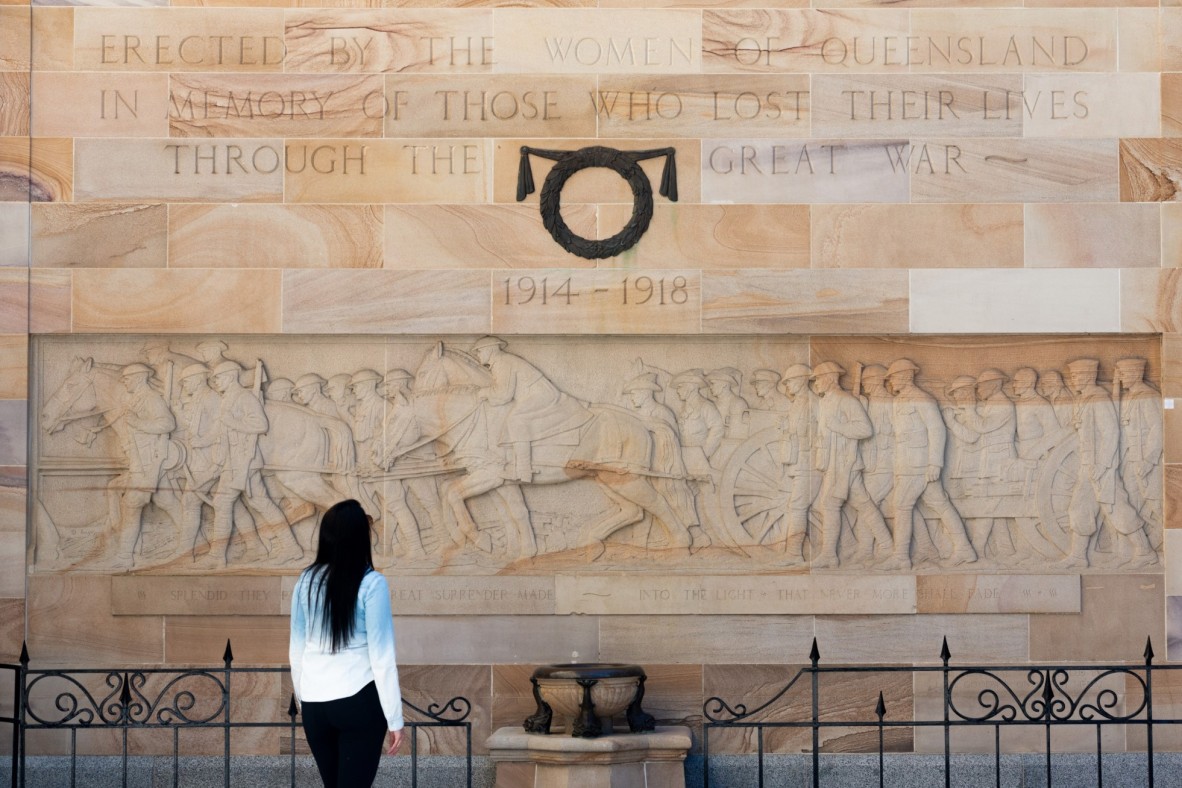
The Women’s Memorial at Anzac Square, photo courtesy Rozenn Leard Photography.
This particular memorial was first conceived at a meeting held in the Brisbane Women's Club in October 1929. At that time, the plans for the layout of the new Anzac Square and cenotaph were finally coming to life. The meeting was attended by representatives of women’s associations and community groups from across the state. There was an enthusiastic discussion about who should be memorialised and the form the memorial should take; some wanted a memorial for women and others thought it should be from women, some wanted acknowledgement of those who died during the war and others for all lives impacted. Eventually it was agreed that the “Women’s Memorial” would be a tribute from all the women of Queensland to all those – men and women – who lost their lives through service in The Great War. A committee was then formed, and a campaign set in motion to encourage all Queensland women to contribute to the realisation of this new memorial. To make it achievable, every Queensland woman would be asked to contribute just one shilling. Thus the “20,000 shillings” – one from every woman – idea was born.
An example of this appeal is a letter from the Premier’s wife, Mrs Nellie Moore addressed “To my sister Queenslanders”, published in the Truth newspaper in July 1930:
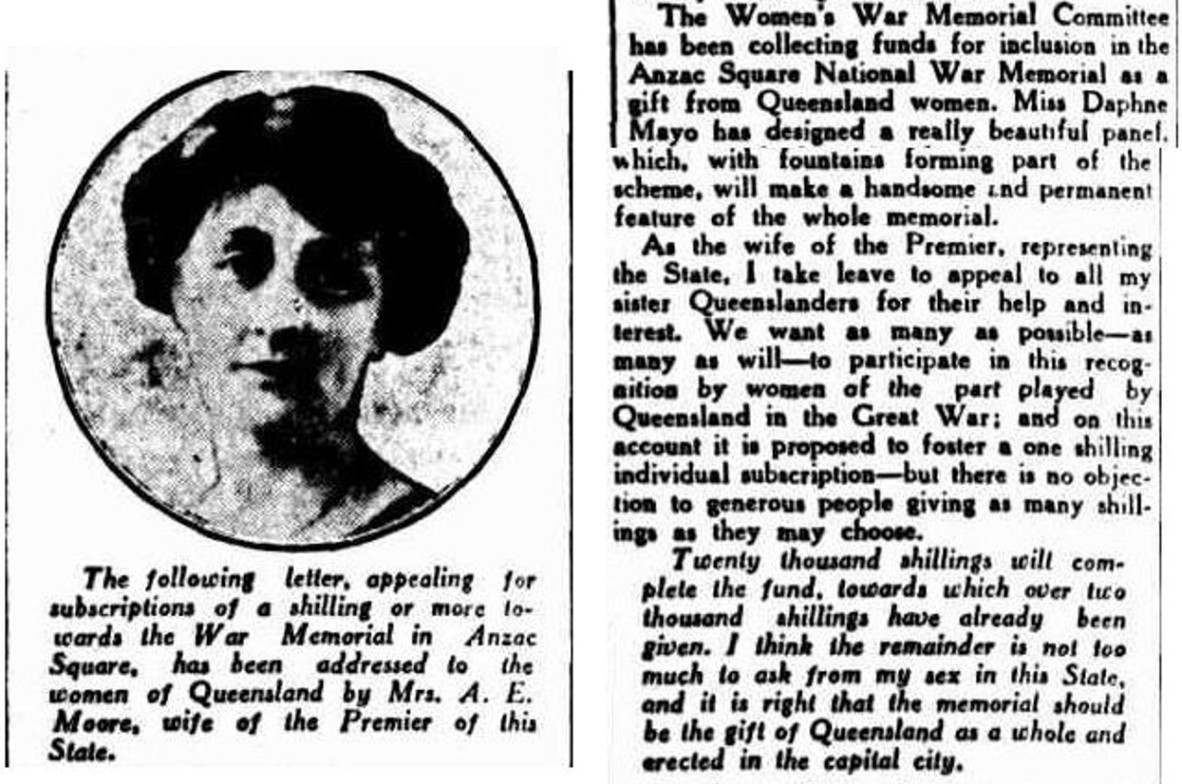
Extract from The Truth, 20 July 1930, p. 20. (You can read this article in Trove: http://nla.gov.au/nla.news-article206158421.)
Notably, in addition to being a memorial offering on behalf of women, the sculpture was also designed and created by a woman – the renowned Brisbane sculptor Daphne Mayo. At the time of this commission, Miss Mayo was one of the most celebrated figures in the state’s still-fledgling artistic community, and a highly-skilled, classically-trained professional sculptor. Her previous sculptural works for the city – such as for the Tattersall’s Club and the Brisbane City Hall Tympanum – had demonstrated both her artistic vision and technical proficiency in merging large scale monumental sculpture with architectural design.
Initially, Miss Mayo proposed a tablet cast in bronze, but the timing of the fundraising campaign would prove problematic for this ambition; shortly after that meeting at the Brisbane Club, the Great Depression would hit both the Queensland economy and family finances hard. The original plans for a bronze memorial and two fountains were thus modified, and eventually a plan was agreed for a tablet carved in sandstone, with a single bronze drinking fountain in the foreground. (Plans for the memorial were published in The Queenslander, 23 October 1930. You can read this article in Trove: http://nla.gov.au/nla.news-article23130592.)
Miss Mayo worked on the tablet at Anzac Square through to 1932, including long hours onsite chiselling the figures into the sandstone wall.
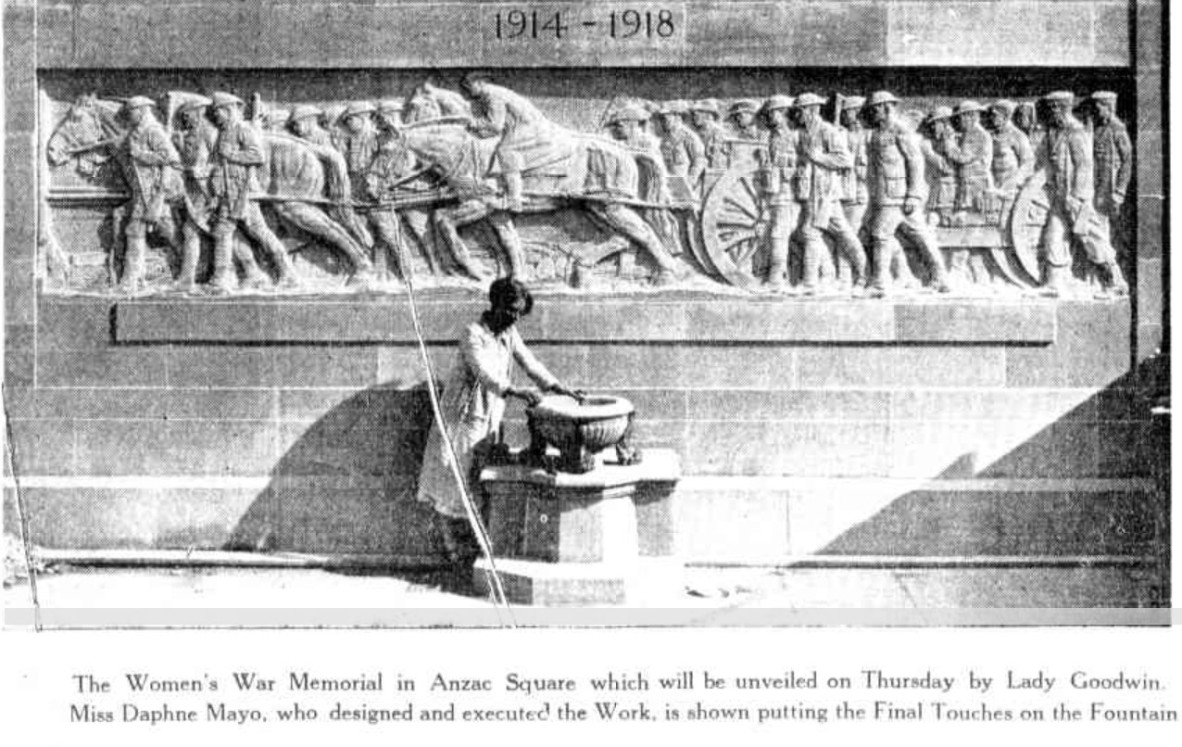
Miss Mayo, photographed “putting the Final Touches” to the memorial at Anzac Square in 1932, published in The Telegraph, 23 Mar 1932, p. 10. (Read this article in Trove: http://nla.gov.au/nla.news-article180049949)
Besides being a professional commission, this was also a personally compelling project for Miss Mayo, as her own brother (Richard Henry McArthur Mayo) had died on 24 Nov 1924, aged just 32, his health having suffered from his war service. He is one of those figures depicted in the tablet, leading the procession which also features a horse-drawn wagon flanked by 23 other men and one woman from all branches of the defence forces. In addition to Captain Mayo (who served with the Army Service Corps), the figures represent the Royal Australian Navy, Field Artillery, Engineers, Signallers, Infantry, Pioneers, Machine-Gunners, Army Medical Corps, Nurses Corps, Veterinary Corps and Flying Corps. The tablet also features an inscription drawn from the hymn “O Valiant Hearts” which was written by British politician Sir John Stanhope Arkwright, in honour of those who died in World War One:
Splendid they passed the great surrender made
Into the light that never more shall fade
The bronze drinking fountain in front of the memorial sits atop a sandstone plinth which features four bronze dolphins at the base, representing salvation. Originally the fountain fulfilled both symbolic and utilitarian functions; it helped to address a shortage of public drinking fountains in the Brisbane Central Business District (CBD) and it was especially designed for children to use.
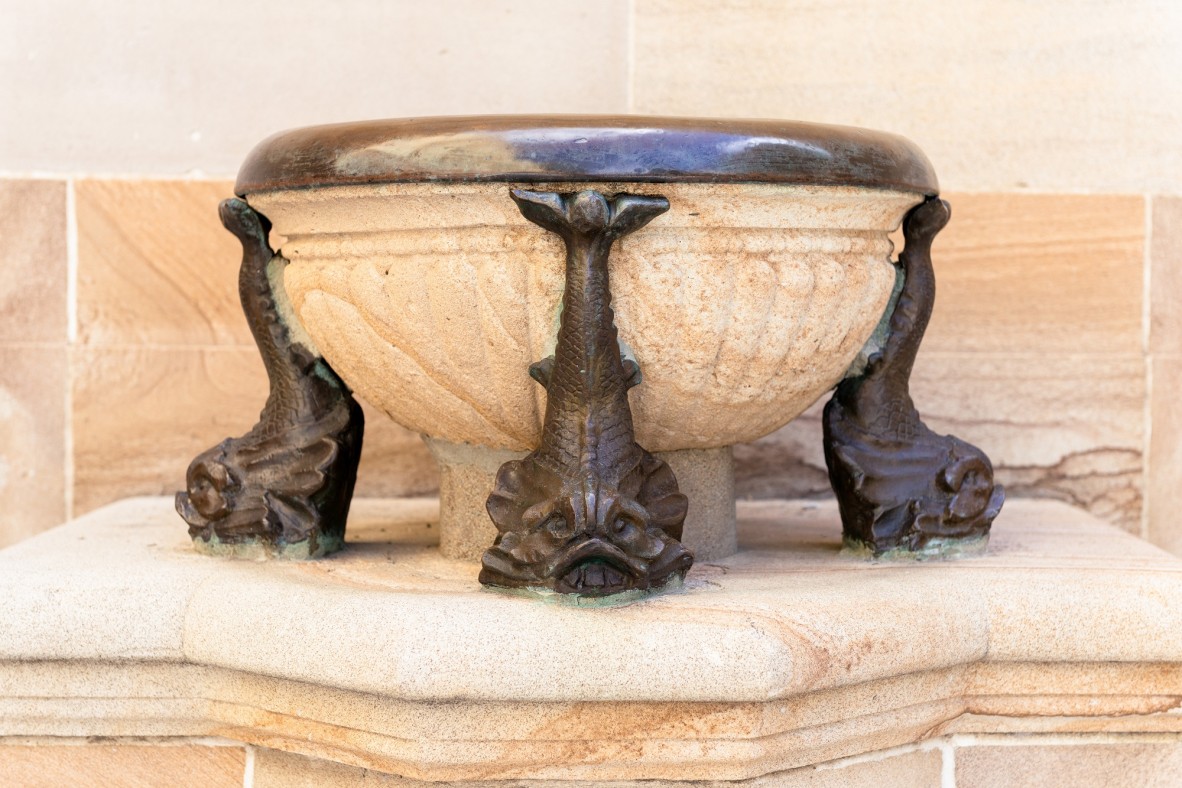
Detail of the fountain at Anzac Square today, photo courtesy of Rozenn Leard Photography.
The Women’s Memorial was unveiled on 24 March 1932 by Lady Goodwin, the wife of the then Governor of Queensland. Since its inception, the Women’s Memorial has formed a backdrop to daily life and the many commemorative events and services held in Anzac Square, including events attended by women over many decades.
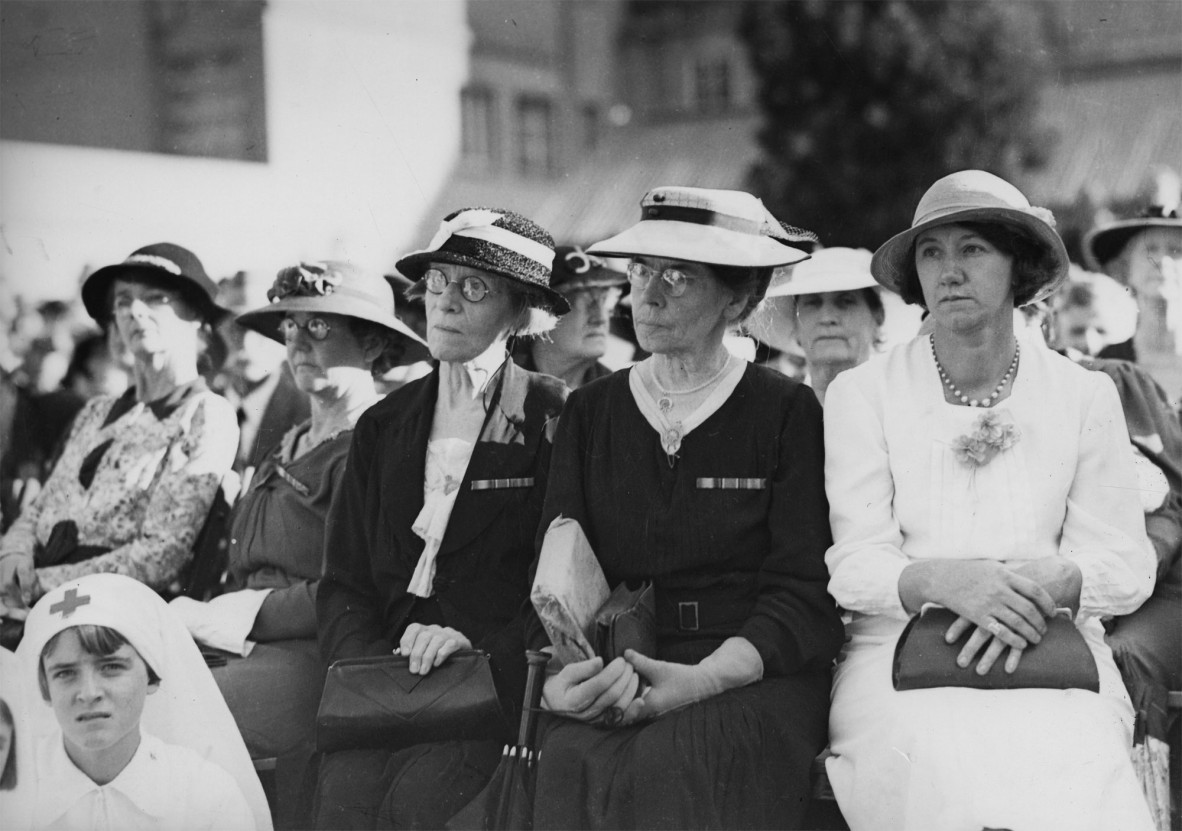
Group of women at the Anzac Day observance, Anzac Square, 1937, State Library of Queensland Negative No. 203403 (https://hdl.handle.net/10462/deriv/199206).
And although the drinking fountain is no longer operational, the memorial’s symbolic legacy, envisioned by those women who met in Brisbane back in 1929, endures.
If you would like to learn more about the experiences of Queensland women during war, from World War I to today, the Anzac Square Memorial Galleries offers free tours and public talks on a variety of topics, including Queensland women’s stories. These events can be booked online via Eventbrite. Appropriately, our public tours usually start at the main entrance to the galleries, beside the women’s memorial. Our interactive galleries also feature many other stories and memorials and are open 10–4, Sunday–Friday.
Links to Eventbrite for the Anzac Square Talk Series or Tours:
Anzac Square Memorial Galleries Talk Series: Our Women's Memorials
Sunday 9 May 2021, 10.30-11.30am
OR
More information
Anzac Square Memorial Galleries - https://www.anzacsquare.qld.gov.au/
Ask Us - /plan-my-visit/services/ask-us
Comments
Your email address will not be published.
We welcome relevant, respectful comments.